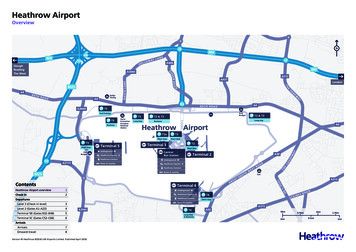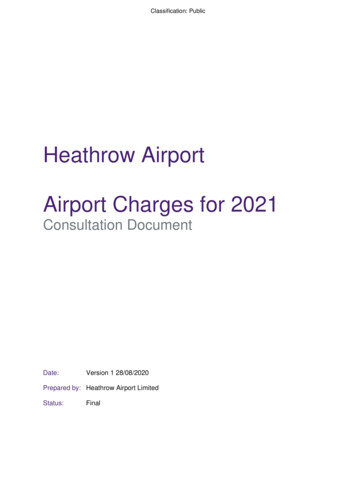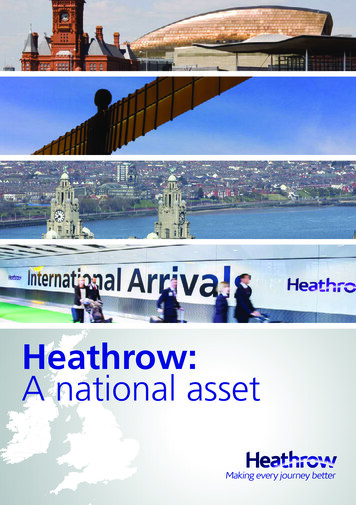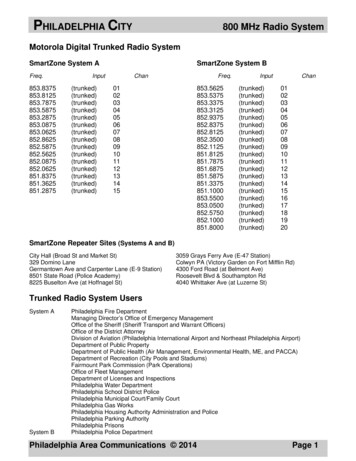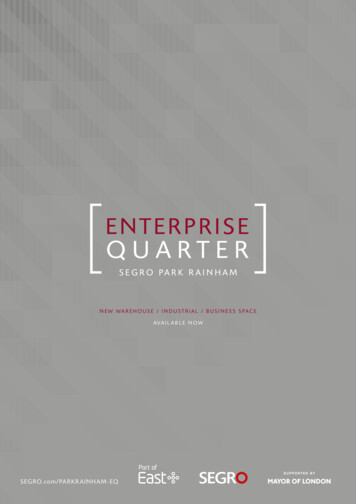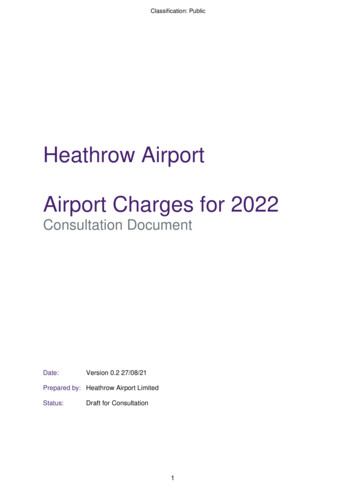
Transcription
Classification: PublicHeathrow AirportAirport Charges for 2022Consultation DocumentDate:Version 0.2 27/08/21Prepared by: Heathrow Airport LimitedStatus:Draft for Consultation1
Classification: PublicContentsExecutive Summary . 3Chapter 1 – Introduction and Consultation Programme . 5Chapter 2 – Calculating the Maximum Allowable Yield. 8Chapter 3 – Correction Factor for 2020 . 11Chapter 4 – Overview of charges . 23Chapter 5 – Calculating airport charges tariffs for 2022. 28Chapter 6 – Forecast Revenue for 2022 . 30Chapter 7 – Proposed Airport Charges Tariffs effective 1 Jan 2022 . 33Chapter 8 - Financial and Traffic Information . 352
Classification: PublicExecutive SummaryOver a year after COVID-19 was declared a pandemic, the impacts on the aviation industryremain dramatic, including at Heathrow.At the start of the pandemic, we worked quickly to protect the business through keepingpeople safe, maintaining service standards, mitigating costs, protecting revenues andpreserving liquidity. We worked with other airports and airlines around the world to set andachieve high standards of COVID-19 safety in the end to end passenger journey, and weimplemented them at Heathrow. Our investment in the latest COVID-19 securetechnologies and processes has seen Heathrow awarded the Skytrax 4* rating, the highestachieved by a UK airport.Whilst fewer than 4 million people travelled through Heathrow in the first six months of2021, a level that would have taken just 18 days to reach in 2019, recent changes to theGovernment’s traffic light system are encouraging. Progress in vaccination rollouts andtesting technologies coupled with lower infection rates both in the UK and abroad haveenabled governments to start easing travel restrictions, however, expensive testingrequirements and travel restrictions are still holding back the UK’s economic recovery.As we prepare for increasing demand, we have taken the step to recommence operationsin Terminal 3 and are once again operating from two runways. This provides additionalcapacity and ensures passengers can travel safely and securely through Heathrow in thecoming months. In addition, in June, Terminal 4 was re-opened as a dedicated facility forarrivals from ‘red list’ countries. These ‘red list’ routes have become a crucial part of theUK Government’s risk-based framework for international travel and this facility serves ‘redlist’ passengers arriving on direct flights only. We anticipate the need for a dedicated facilityfor red arrivals for the foreseeable future.This summer, we started undertaking trials with British Airways and Virgin Atlanticdesigned to support the Government in lifting some of the restrictions for travellers arrivingfrom ‘amber list’ countries. These new trials will provide the Government with evidencethat inbound travellers from all nationalities can present their fully vaccinated status indigital or paper format as proof of their vaccination status. It can be quickly and easilychecked away from the border and allow safe entry to the UK. The aim is to providesufficient reassurance that Government can and will ease restrictions on travel from thosewho have protected themselves and others through completing a recognised vaccinationprogramme.Decarbonising the aviation sector remains a key priority in our sustainable growth plan andwill become a prerequisite for the sector’s growth. In 2020, we achieved a significantmilestone with our airport operation becoming carbon neutral. We welcome theGovernment’s sixth Carbon Budget which will add further impetus on aviationdecarbonisation.In early June 2021, Heathrow became the first major UK airport to successfully integrateSustainable Aviation Fuels (SAF) into its operation, ahead of the G7 Summit. SustainableAviation Fuels are key to taking the carbon out of flying – but the Government must actnow to introduce a mandate that requires a minimum of 10% SAF use by airlines by 2030,rising to at least 50% by 2050. Currently, 62% of Heathrow airlines have committed to 10%SAF by 2030, ahead of the Climate Change Committee target of 7.5%. Additionally, weare leading an 18 month ten-strong consortium, funded by the Innovate UK ‘Future Flight’programme, researching the introduction of hydrogen and electric aircraft into the aviationsystem.Taking the carbon emissions out of flying remains an ethical and business imperative forHeathrow. We are playing a leadership role to create momentum to solve the problemacross all our carbon emission scopes.3
Classification: PublicIn addition to our focus on carbon, we continue to take our overall sustainability objectivesseriously. We anticipate that 2022 will be a year of recovery, when passenger confidenceand ability to fly starts to build back; it is important that we encourage this to happen in themost sustainable and responsible way, minimising impacts on those who live around theairport, on our local environment and noise.Challenges remain, but long-term recovery will be secured through stimulating andstabilising passenger volumes – this objective sits at the heart of Heathrow’s proposedpricing structure. We will do this while retaining our collective focus on sustainability.To secure the recovery of passenger volumes, the ultimate objective of our pricingproposal is to attract passengers, while maintaining responsible investment in our worldclass passenger terminals and operational facilities which is key to maintaining the levelsof service that our airlines and passengers expect. We will do this while maintaining a safe,reliable operation which balances service and financeability.Heathrow is proposing to set 2022 prices to recover a yield of 37.636 per passenger.Our 2022 consultation proposal includes: Increasing the proportion of the maximum allowable yield recovered via movementcharges to incentivise efficient and sustainable use of airport assets through higherload factors;Incentives to encourage efficient airline build-back, increase consumer choiceand promote UK connectivity;Introducing a new Sustainable Aviation Fuels incentive to encourage uptake atHeathrow and stimulate UK production by signalling a multi-year commitment;Introducing a weight-based cargo charge to reflect proportionate, efficient andsustainable use of airport assets; andA new super low noise chapter to continue efforts to reduce impacts on theenvironment via the use of best in class aircraft and mitigate the impact of flying onthose who live around the airport.Publication of this consultation document initiates the consultation process. We are keento listen to customer feedback throughout this process and we thank those who havealready expressed early views.Heathrow will be holding a consultation meeting on 9 September 2021. To help inform theconsultation, Heathrow requests written responses from the airline community by 1October 2021. Heathrow will consider all comments received during the consultationperiod, ahead of issuing a decision by 31 October 2021 for implementation from 1 January2022.4
Classification: PublicChapter 1 – Introduction and Consultation ProgrammePurpose1.1The purpose of this document is to set out Heathrow’s proposal for the level ofairport charges and invite the airline community to provide views on the proposals.1.2We are proposing to set airport charges for 2022 based on our latest businessplan, submitted to the Civil Aviation Authority as part of the H7 price control reviewprocess1. Our plan is in the interests of consumers, it is based on extensivestakeholder engagement, and it has been formulated from a solid evidence base.We are therefore confident that using this price is in the best interest of all airportusers.Economic Regulation1.3In December 2012, the Civil Aviation Act 2012 (the “Act”) came into force. The Actallows the CAA to set the maximum yield per passenger that may be levied byHeathrow through the application of the price control conditions under a newlicence. The existing price control conditions expire at the end of 2021, and noprice control condition is in place for the start of 2022. The CAA is currently in theprocess of determining the price control condition for the period 2022 to 2026 andhas not yet confirmed their intentions for this. This process is anticipated to resultin new price control conditions in Q2 2022.1.4Airport charges are levied on operators of aircraft in connection with the landing,parking, or take-off of aircraft at the airport (including charges that are to any extentdetermined by reference to the number of passengers on board the aircraft)2.1.5Under the terms of the Q6 Licence the CAA requires Heathrow to (i) meet servicequality conditions and (ii) consult on capital investment and other regulatedcharges. Whilst these provisions will cease to have effect from 1 January 2022Heathrow is voluntarily committing to continue to operate, and charge, as thoughthey were effective.1.6The CAA conditions for service quality require Heathrow to make payments toairlines if it fails to meet the assigned targets. The service quality measures include:terminal seat availability; cleanliness; way-finding; flight information; passengersensitive equipment; arrivals reclaim; stands; jetties; pier service; fixed electricalground power; pre-conditioned air; central security queuing; transfer securityqueuing; staff security queuing; control post queuing; stand entry guidance; andtrack transit system. Further details on the service quality measures andperformance can be found at www.heathrow.com3. Our service quality regime willremain in place in 2022.1.7Details of Heathrow’s capital investment plan can be found at www.heathrow.com4,a list of other regulated facilities and services can be found atwww.heathrow.com/orc and a list of property accommodation can be found atwww.heathrow.com/property. In addition, the full schedule of airport charges islisted in the Conditions of Use, which can be found at he Airport Charges Regulations bout-heathrow/economic-regulation/h7-update25
Classification: PublicImpact of COVID-191.8The years 2020 and 2021 have been the toughest years by far in Heathrow’s 75year history. By 30 June 2021, Heathrow’s cumulative losses from COVID-19 hadgrown to 2.9bn. We have taken decisive management action from the start of thepandemic to protect jobs and the financial resilience of the business. We reducedcash burn by over 50% versus H1 2019, with a 35% reduction in operating costsby 35% and cut capital expenditure by 77%.1.9Nonetheless, there has been a significant impact on the regulatory building blockswhich calculate the minimum required revenue and set out the required airportcharge on an annual basis. If Heathrow were proposing to use a pure building blockformula for calculating the charge for 2022 – a year which will start without a pricecontrol in force – the result would be a charge of 62.55 (2018 prices). Recognisingthe negative implications such an increase on the charge would have on all usersof the airport, we are proposing an alternative for the 2022 airport charge which isdriven by financeability responsibilities to the airport ecosystem rather than purelyusing regulatory building blocks to determine the required revenue. Further detailis set out in Chapter 2.Approach to setting the 2022 airport charge1.10 The CAA modified Heathrow’s licence on 21 December 2016 under section 22 ofthe Act. The modifications extended the current price control for Heathrow, whichinitially ran from 1 April 2014 to 31 December 2018, by one year so that it wouldend on 31 December 2019. The modification rolled over the existing control in thelast year of Q6 on the same terms, i.e. a price path of the Retail Price Index (RPI)-1.5%. In April 2018, the CAA confirmed that an interim regulatory period would beimplemented ahead of the H7 period. This period started on 1 January 2020 andruns until 31 December 2021 and is known as the interim H7 period or iH7. TheCAA confirmed the implementation of the iH7 period through its notice of licencemodifications in November 2019, with modifications effective from 1 January 2020.1.11 The price control condition in Heathrow’s Licence expires on 31 December 2021.This means that pending further information or decisions from the CAA, theprevious RPI-X formula does not apply in respect of 2022 charges. The CAA iscurrently considering the price conditions that should apply between 2022 and2026 and this process is anticipated to complete in Q2 2022.1.12 Given the lack of information from CAA regarding its decision on the H7 pricecontrol or its approach to 2022, Heathrow has engaged separately with the CAAand airline community on the approach to setting charges for the start of 2022. Weprovided information supporting the 2022 charge in our Revised Business Plan(RBP) that was published in June 2021. As at the time of publishing thisconsultation, no decision has been reached by the CAA or agreement betweenCAA, airline community and Heathrow on a specific charge level for the start of2022. Therefore, Heathrow is consulting on the basis of the 2022 yield set out inthe update to its RBP, published in June 2021.1.13 The charge is the profiled 2022 charge as set out in the RBP Update 1, which is 39.848 (outturn price).1.14 We plan to apply these charges in a manner consistent with the price formula thatapplied in previous years, and therefore we have included an adjustment to reflectover-recovery compared to the price cap in 2020. When the Correction (K) Factorof 2.212 (outturn price) is applied, the charge reduces to 37.636.6
Classification: Public1.15 The CAA is currently working towards its view of the price control formula thatshould apply from 2022 to 2026 (H7) and has indicated that it plans to publish itsInitial Proposals later this year with a final decision currently likely in Q2 2022. Thecharge the CAA determines for 2022 may be different from that on which we arecurrently consulting. The implications of this for the 2022 charge are not currentlyclear and Heathrow will work with airlines and the CAA as the H7 outcomebecomes clear. We welcome views as part of consultation responses on the bestresponse to the CAA final proposal with respect to the aeronautical charge.Consultation Programme1.16 Heathrow is consulting on the level of charges for 2022 with the airline communityand plans to announce its final decision by 31 October 2021, in accordance withthe requirements of the Airport Charges Regulations 2011. The publication of thisconsultation document is the start of our consultation on the annual setting ofairport charges.1.17 The consultation programme is as follows:Table 1Date31 Aug 202109 Sep 202101 Oct 202131 Oct 20211 Jan 2022MilestonePublication of Heathrow consultation documentConsultation meetingAirline written responses submitted by close of businessHeathrow announces 2021 pricesPrices and updated Conditions of Use applicable1.18 The consultation meeting will be held on 9 September 2020 which will provide theairline community with the opportunity to comment on the pricing and Conditionsof Use proposals, in addition to providing any written comments by 1 October 2020.The meeting will be open to all airlines and their representative bodies.Date:Time:Location:Thursday 9 September 202014:30 to 16:30Microsoft Teams Meeting1.19 Please let us know if you would like to attend the consultation meeting using theemail address provided below.How to Respond1.20 We invite interested parties to submit written responses to the proposals set out inthis document by close of business on 1 October 2020. Responses should be sentto: airline relations@heathrow.com. You should also use this email address inthe event you have any questions on the consultation document or associatedprocess.1.21 Please clearly mark any information that should be treated as confidential inresponses to this consultation.7
Classification: PublicChapter 2 – Calculating the Maximum Allowable Yield2.1The price control condition in Heathrow’s Economic Licence expires on 31December 2021. The previous RPI-X formula is therefore no longer legallyapplicable in respect of calculating the 2022 airport charges.2.2Heathrow is therefore consulting on the basis of the 2022 yield set out in the updateto its RBP, published in June 2021. Our plan is in the interests of consumers, it isbased on extensive stakeholder engagement, and it has been formulated from asolid evidence base. Full details of our business plan can be found /economic-regulation/h7-update2.3The proposed maximum allowable yield as set out in RBP update 1 is 39.848(outturn price).2.4Table 1 below sets out the basis of the charge.Table 1: RBP Building blocks for the 2022 airport charge options millions, 2018 pricesOpexNon aeroCargo revenueReturn on RABDepreciationRevenue requirementPassengersUnprofiled yield, Depreciation deferralProfiling adjustmentAero revenueFinal RBP yield, BRBP Charge1,054-733-161,5148822,701AB/A43.262.55CDE B C DE/A-635-5201,54635.81Source: Heathrow2.5The 2018 prices are converted to outturn in the table below using the followingcalculation, which is consistent with the conversion approach used previouslythrough the price control condition:Charge (2018p) x (RPI April '21: 301.1 / RPI April '17: 270.6) Charge (Outturn)2.6While it is not required to use the normal RPI-X formula to calculate the 2022 airportcharge, we have adopted an approach that is consistent with the iH7 price controlcondition. Therefore, we have applied the correction (K) factor in a way which isconsistent with the Q6 licence to ensure that any over or under recovery againstthe maximum allowable yield from 2020 has been accounted for. The K Factor setsout the level of over-recovery or under-recovery on a per passenger basis. Overrecovery is when Heathrow exceeds the maximum allowable yield on a per8
Classification: Publicpassenger basis. Under-recovery is when Heathrow does not achieve themaximum allowable yield on a per passenger basis. Since Heathrow overrecovered in 2020, the charge has been reduced by 2.212. The K factor has beencalculated using the pre-shock factor 2022 passenger forecast, which is consistentwith the approach used in previous years. Further details are provided in Chapter3 – Correction Factor for 2020.2.7The final charge is 37.636 (outturn price), as presented in Table 2 below.Table 2: Final 2022 charge adjusted for inflation and K factorRBPCharge2018pConvert to outturn K factor (2020 2022Chargeusing April 17 to April over-recovery)adjusted for K factor21 RPI(outturn)(outturn) 35.812 39.848 2.212 37.636Source: HeathrowMinimum revenue requirement2.8By 30 June 2021, Heathrow’s cumulative losses from COVID-19 had grown to 2.9bn. We have taken decisive management action from the start of thepandemic to protect jobs and the financial resilience of the business. We reducedcash burn by over 50% versus H1 2019, with a 35% reduction in operating costsby 35% and cut capital expenditure by 77%. Despite these actions, as with mostinfrastructure businesses, there remain material fixed elements of our cost base,which are spread across a significantly reduced passenger base; fewer than 4million people travelled through Heathrow in the first six months of 2021, a levelthat would have taken just 18 days to reach in 2019. Our passenger forecast for2022 is far below the pre-pandemic 80.9m passengers we served in 2019.2.9COVID-19 has resulted in a significant impact on the regulatory building blockswhich calculate the minimum required revenue. The result of using the buildingblock formula, based on the forecast reduction in passenger numbers for 2022,would be a charge far greater than the option we are presenting in this consultation.The proposal under consultation reflects the yield required to meet Heathrow’sminimum revenue requirement to meet financeability obligations for 2022, andresults in less revenue than the cost of providing the service. The building blockcost would be equivalent to a 62.55 charge (2018p) in 2022. The proposed chargeof 35.81 (2018p pre-K factor) in 2022 is therefore significantly less than thisamount.2.10 The charge for 2022 in the RBP is significantly below that required to recover thecost of providing airport services and has been determined by assessing theminimum level of revenue required to ensure that Heathrow does not suffer from afurther downgrade by credit rating agencies (see RBP Update 1 Chapter 5.7). Sucha downgrade would lead to higher costs in the long run and would reduce the abilityof the airport to invest in appropriate service and resilience leading to worseoutcomes for passengers. We consider that the proposed charge is in the longterm interests of consumers.9
Classification: PublicH7 Changes to the 2022 Charge2.11 Our business plan includes changes related to Other Regulated Charges (ORCs),firstly removing business rates from the airport charge and placing them into aseparate ORC, and secondly recovering allocated costs and annuities through theairport charge rather than through ORCs. Both of these H7 proposals have beenfactored into the 2022 airport charge options.2.12 The impact of removing business rates from the airport charge is a reduction of 95m (2018 price).2.13 The impact of including allocated costs and annuities in the 2022 airport charge is 49m (2018 price).2.14 Further detail on the rationale for these changes is set out in our RBP Update 15.2.15 As part of the price control condition in setting the maximum allowable yield, wewould normally include an SQRB bonus adjustment to account for any bonusesthat have been accrued two years prior (for 2022 charges the relevant year is2020). We earned 296,000 in bonuses in 2020. These have not been included inthe charge for 2022 to maintain simplicity and transparency. However, we expectthe 2020 bonus to be included within the calculation of the K factor correctionmechanism in 2024. We also expect any bonuses incurred for 2022 to berecovered through future charges.2.16 For completeness, the 2022 airport charge options do not reflect any proposed H7changes to the Service Quality Rebates and Bonuses / Outcomes BasedRegulation scheme.2.17 The CAA plans to publish its final decision for H7 sometime in 2022 and we willreflect on whether this requires Heathrow to amend its charge when we have clarityon the CAA’s decision making. We welcome views as part of consultationresponses on the appropriate course of action at this hrow/economic-regulation/h7-update - RBPUpdate 1 pp252-253, June 202110
Classification: PublicChapter 3 – Correction Factor for 2020The Correction factor3.1The K Factor sets out the level of over-recovery or under-recovery on a perpassenger basis. Over-recovery is when Heathrow exceeds the maximumallowable yield on a per passenger basis. Under-recovery is when Heathrow doesnot achieve the maximum allowable yield on a per passenger basis. Thisover/under-recovery generally reflects a change in mix of actual passengers andmovements compared to the forecasts used to set the airport charges for thatrelevant year. During the period from the start of the pandemic, we have beensubject to significant forecast uncertainty which has led to the over-recovery weexperienced in 2020. While it is not required to use the normal RPI-X formula tocalculate the 2022 airport charge, we have applied the correction (K) factor toensure that any over or under-recovery in 2020 has been accounted for in amanner consistent with the Q6 licence.3.2The K Factor formula has a component to calculate the actual allowable yield, theK Factor formula is shown below:R (Qt 2 M t 2 ) I t 2 K t t 2 1 Qt 100 2Formula for 2020 actual maximum allowable yield3.33.4The combined impact of all the elements of the formula results in 2020 actualmaximum allowable yield of 21.738 (passenger only flights). 2020 is theRegulatory Period from 1 January 2020 to 31 December 2020. The section belowpresents the components of the formula.M t 2relates to 2020 and its calculation is shown below:𝑀2020 (1 𝑅𝑃𝐼𝑡 1 𝑋 𝐵𝑡 2 )𝑌𝑡 1 𝐷𝑡 𝑇𝑡 𝐴𝑡 𝐵𝑅𝑡 𝐾𝑡𝑄𝑡 𝑄𝑡 𝑄𝑡𝑄𝑡Where:M2020 maximum revenue yield per passenger using Heathrow airportin Regulatory Year (“2020”) expressed in pounds.RPIt-1 is the percentage change (positive or negative) in the Officefor National Statistics (ONS) CHAW Retail Price Indexbetween April in year t-1 and the immediately preceding April.For 2020 this would be the change from April 2018 to April2019.X -1.5%Bt-2 The formula includes a bonus factor that allows the airport torecover a bonus when performance on certain service qualitymeasures exceed a specified service standard. The bonus11
Classification: Publicterm in any given year is based on actual service quality,based on the two year period preceding the relevant year.Yt-1 specified average revenue yield per passenger for the periodt-1 (2019).Dt cumulative development capex adjustment.Tt reduction in maximum allowable charges when the airport hasnot achieved specific trigger dates associated with relevantprojects (Triggers).At cost pass-through for runway expansion.BRt business rates revaluation factor.Kt correction factor (K Factor) per passenger (whether positiveor negative value) for 2018.Qt actual passengers using Heathrow airport in 2020.Application of the Regulatory Pricing FormulaWhere :RPIt-1XBt-2Yt-1DtTtAtBRtQtKt 3.00%-1.5%0.042% 23.183- 40,154k 3,072 10,000- 34,63822,110k-1.267- this figure is an actual- this figure is an actual- this figure is an actual- this figure is an actual- this figure is an actual- this figure is an actualHence:𝑀2020 (1 𝑅𝑃𝐼𝑡 1 𝑋 𝐵𝑡 2 )𝑌𝑡 1 𝑀2020 (1 3.00% 1.5% 0.042%)23.183 𝐷𝑡 𝑇𝑡 𝐴𝑡 𝐵𝑅𝑡 𝐾𝑡𝑄𝑡 𝑄𝑡 𝑄𝑡𝑄𝑡( 40,154) 3,072 10,000 34,638 ( 1.267)22,11022,110 22,11022,110𝑀2020 (1.015 23.183) ( 1.816) 0.139 0.452 ( 1.567) 1.267𝑀2020 21.7383.5The actual maximum allowable yield for 2020 is 21.738.12
Classification: Public3.6The components of the formula are explained in the following sections.Bonus term (2018)3.7The regulatory pricing formula includes a bonus factor that allows the airport torecover a bonus when performance on certain service quality measures exceed aspecified service standard. The bonus term in any given year is based on actualservice quality, based on the two year period preceding the relevant year3.8Therefore the k factor for 2020 includes a bonus for the period 2018, of 0.042%.Cumulative development capex adjustment3.9The cumulative development capex adjustment adjusts the actual maximumallowable yield to account for the actual difference between the development capexallowance and actual development capex spend. Heathrow has used less than thedevelopment capex allowance on a cumulative basis to 2020.3.10 The below table sets out the formula used to calculate the cumulative developmentcapex adjustment. The 2020 formula is used:13
Classification: PublicYear 𝐭 2015201620172018201920200.5 d2014Pt 1 d2014Pt 2Pt 1 d2014Pt 3Pt 1 d2014Pt 4Pt 1 d2014Pt 5Pt 1 d2014Pt 6Pt 1 d2014Pt 700.5 d2015Pt 1 d2015Pt 2Pt 1 d2015Pt 3Pt 1 d2015Pt 4Pt 1 d2015Pt 5Pt 1 d2015Pt 6000.5 d2016Pt 1 d2016Pt 2Pt 1 d2016Pt 3Pt 1 d2016Pt 4Pt 1 d2016Pt 50000.5 d2017Pt 1 d2017Pt 2Pt 1 d2017Pt 3Pt 1 d2017Pt 400000.5 d2018Pt 1 d2018Pt 2Pt 1 d2018Pt 300000.5 d2019Pt 1 d2019Pt 29mo.2014Additional revenuerequirementfor2014 projectsAdditional revenuerequirementfor2015 projectsAdditional revenuerequirementfor2016 projectsAdditional revenuerequirementfor2017 projectsAdditional revenuerequirementfor2018 projectsAdditional revenuerequirementfor02019 projectsAdditional revenuerequirement0.5 d2020for2020 projectsDt Sum RowsxWSum RowsxWSum RowsxWSum RowsxWSum RowsxWSum RowsxWWhere:W 4Pt-5Pt-6Pt-7 Weighted Average Cost of Capital which shall have a value of5.35%Annual development capex adjustment in 2014Annual development capex adjustment in 2015Annual development capex adjustment in 2016Annual development capex adjustment in 2017Annual development capex adjustment in 2018Annual development capex adjustment in 2019Annual development capex adjustment in 2020ONS CHAW Retail Price Index in April in 2019 is 288.2ONS CHAW Retail Price Index in April in 2018 is 279.7ONS CHAW Retail Price Index in April in 2017 is 270.6ONS CHAW Retail Price Index in April in 2016 is 261.4ONS CHAW Retail Price Index in April in 2015 is 258.0ONS CHAW Retail Price Index in April in 2014 is 255.7ONS CHAW Retail Price Index in April in 2013 is 249.5D2017: Annual development capex adjustment is calculated as follows:14Sum RowsxW
Classification: PublicP d 2014 O2014 V2014 t 1 222 .80 O2014 363,400kV2014 439,100kPt-1 ONS CHAW Retail Price Index in April 2013 is 249.5249.5 d 2014 363,400 439,100 222.8 d2014 - 128,321kHence d2015:P d 2015 O2015 V2015 t 1 222 .80 O2015 590,000kV2015 669,000kPt-1 ONS CHAW Retail Price Index in April 2014 is 255.7255.7 d 2015 590,000 669
of service that our airlines and passengers expect. We will do this while maintaining a safe, reliable operation which balances service and financeability. Heathrow is proposing to set 2022 prices to recover a yield of 37.636 per passenger. Our 2022 consultation proposal includes:
